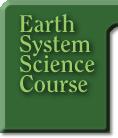Week
2: Yellowstone Causal Chains
The interactions
that occur within Earth's system actually occur as a series of
chain reactions, which ripple throughout Earth's spheres. This
means that an event often leads to a change in one sphere,
which leads to a change in another sphere, which leads to a
change in yet another sphere. For example:
- A forest fire
destroys all the plants in an area (E > B).
- The absence of
plants could lead to an increase in erosion of soil (B
> L).
- Increased
amounts of soil could enter streams, which could lead to
increased turbidity, or muddiness, of the water (L >
H).
- Increased
turbidity of stream water could have a negative impact on
the plants and animals that live in the stream (H > B).
The four
interactions above can be written as a causal chain to
synthesize the results of the ESS analysis and to describe how
the event can lead to a ripple of effects throughout the Earth
system. Causal chains show the interdependence of Earth's
spheres. The causal chain for the forest fire event outline
above can be summarized in the narrative form below:
E > B
> L > H > B
The
fire consumed the vegetation. A decrease in
vegetation could have resulted in increased soil
erosion because there were fewer roots to hold
the soil in place. Increased erosion of loose
soil could have led to increased soil particles,
or sediments, in streams. This would make
stream water "muddier." Sediments in the
water could have clogged the gills of fish and
other aquatic organisms and choked them.
Below are two
simple causal chains.
A > B
> E
I read
that more than eight weeks of warm to hot,
low humidity air masses drew moisture out
of grasses and trees in Yellowstone National
Park prior to the 1988 fires.
E > A
> E
The
intense fires created their own upward air movement,
increasing the wind velocity and drawing
in oxygen at the base of the flames to continue
to feed the fire.
Notice that in
the case above the causal chain goes from the event to a
sphere then back to the event. Causal chains don’t always
have to go just from an event to one sphere then another
sphere. They can also go back to the event.
Here is a more
complex illustration of an ESS causal chain:
E > L
> B > L > B > L > H > B
Heat
from the fires can affect the topsoil. As an illustration,
the fires baked out a lot of the living, nutrient-rich
organic matter, called humus. This may
make it more difficult for many of the plants
to start growing again. However, burned plant
debris that did not blow away becomes part
of the new soil and can provide some nutrients
for pioneer plants, much like gardeners
prepare their soil with ashes from a fireplace.
However, because soil moisture is extremely
low due to the fires, surviving seeds of
all types, plus windblown seeds and spores, cannot
germinate until new rains fall in the area.
[ Back
to The Integration of the ESS Analysis
and the PBL Model ]
[ Go to Yellowstone
Event to Sphere Interactions]
[ Go to Yellowstone
Sphere to Sphere Interactions ]
[
Back
to Outline ]
[
Home ] [ Intro
] [ Guide ] Outline [ Classroom
]
HTML code
by Chris Kreger
Maintained by ESSC Team
Last updated July 27, 2000
Privacy
Statement and Copyright©
1997-2000 by Wheeling Jesuit University/NASA Classroom of the Future™. All
rights reserved.
|



